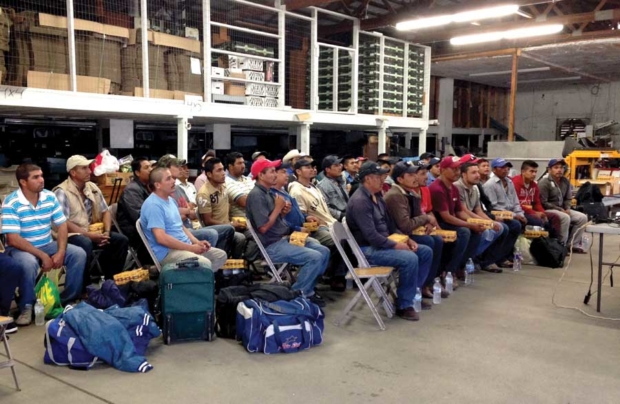
Great Lakes Agricultural Labor Services provides training and orientation to incoming workers immediately upon arrival, as they did here, on the Leitz brothers’ farm near Sodus, Michigan on June 27, 2015. (Courtesy Fred Leitz)
Two years ago, when seasonal farm labor began getting scarce in the Midwest, Michigan Farm Bureau leadership looked to the Washington fruit industry’s handling of the same problem.
In February 2015, the Farm Bureau formed a company called the Great Lakes Agricultural Labor Services LLC. Fashioned after the Washington Farm Labor Association (now known as WAFLA), the new member service program worked with 10 farmers to bring 407 H-2A workers into Michigan last year.
This year, the program is doubling in size. The company brought its first crew to the state to pick red peppers in late March.
“We retained all 10 clients this year, found 10 more and will be bringing in 800 to 900 workers this year from February through late November,” said Bob Boehm, GLALS’s manager.
Growers have to deal with six agencies before they can bring H-2A laborers to Michigan, he said. GLALS helps its clients complete and submit the complicated paperwork because there is a little less than a two-week window to get it all done.
“It can be overwhelming, but GLALS breaks it down into steps. It’s a grower-friendly service,” said Fred Leitz, a Sodus, Michigan, fruit and vegetable grower, who contracts with the firm.
For now, all the workers GLALS brings in come from Mexico. The company recruits workers, arranges transportation to and from Mexico, brings workers to the farms where they will be employed, and provides contracts and training.
Prior to arrival, workers know what jobs they will be doing, as well as their work hours, wages and duration of their contracts.
When workers arrive, GLALS provides bilingual support for training, housing and health information.
Once workers arrive in Michigan, growers provide transport each week to places like the bank and grocery and other retail stores.
Growers, meanwhile, know their laborers are in the country legally.
For the past four years, Fred Leitz and his three brothers left crops in their fields and apples on the trees.
Like so many other growers in North America, they’ve recently discovered they can no longer depend on what was once a vast labor pool to pick and pack their products.
The brothers farm 600 acres intensively, all in plasticulture and drip irrigation. The fourth generation to farm the land, they raise blueberries, tomatoes, cucumbers, apples and cantaloupes, all for fresh markets in the Midwest and the East.
They hire 250 people annually, which includes some full-time, local people. In the summer, the Leitzes hire 175 workers for harvesting and another 60 for packing.
“We have always hired from the migrant stream,” Leitz said.
They hired locally and had 80 percent of their work force returning each year — until four years ago. “It’s been four years since we’ve been able to harvest all our crops,” he said.
Leitz said there are two reasons for the labor shortage he and his brothers are experiencing. One is an aging labor pool and the other is a border situation unfavorable to farm labor. As president of the National Council of Agricultural Employers, a trade association located in Washington, D.C., representing agricultural employers, Leitz has visited Congress several times to try to gain dispensations for farm labor.
With no ready solution presenting itself, Leitz said he was forced to hire H-2A labor. After looking around at a few firms, he settled on Michigan Farm Bureau’s Great Lakes Agricultural Labor Service.
Leitz said there are a lot of good H-2A agents in the country, and most are NCAE members. “We chose Great Lakes because they were close and we liked the way they interact with growers and workers,” he said.
One of the things he likes is that not everyone who applies is accepted as a client. “GLALS staff comes to your farm and does a real good audit to see if it is in compliance with the H-2A program regulations. If you fail, they tell you why and what you have to do to come into compliance,” he said.
The company also runs four to five on-farm sessions a year to bring growers up to date on the program. “They tell us, here’s where you are, here’s what you have to do and here’s what’s coming,” Leitz said.
This year, Leitz has 150 H-2A workers coming to his farm under two contracts, one starting in late April and the other starting in June. Both end in mid-October.
Leitz warned H-2A will only solve labor shortages. “If you have labor issues, it will not correct that problem,” he said. “You have to straighten all that out before you get involved with this program. People have to like working for you or this will not work out.”
He also warned potential participants to follow the program’s regulations exactly as they are written. “You have to do it the way the U.S. Department of Labor tells you to do it. It doesn’t pay to do it your way.” •
– by Dave Weinstock






Leave A Comment